|






| |
Charles uses a Hutech-modified Canon 5D Mk II dSLR and an unmodified Canon 7D for astrophotography.
He uses a Tele Vue NP-101 apochromatic refractor mounted on a Losmandy G-11 for
visual observing and astrophotography, a Borg 77mm apochromatic refractor
mounted on a Vixen SX Sphinx mount.
For current images, please refer to
Charles'
Zenfolio Online Gallery (see above slideshow).
Please note: the page below contains an archive of Charles' images
dated from 2005 through mid-2007.
| Comet Lovejoy C/2007 E2 and NGC 6015 - May 18, 2007
This picture of comet Lovejoy and NGC 6015 was taken from John McDonald's
backyard. Interestingly, I was reading from Wikipedia that comet Lovejoy was
discovered using a Canon 350D DSLR!
Taken: May 18, 2007 from Fairfield
Optics: Canon 200mm f/2.8 Lens on Kenko SkyMemo Mount. Lens stopped down to
f/3.5.
Camera: Canon 20Da
Exposures: 60 light frames of 30 sec @ISO 400. Total exposure time: 30
minutes.
Processing: ImagesPlus- Dark, and flat calibration. Files combined using
MinMax Excluded. Digital Development. Photoshop- Colour balance. Neat Image-
Noise reduction. |
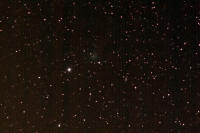 |
| Antares and Rho Ophiuchi Nebulae - May 10, 2007
This is the best of two attempts at imaging the Antares and Rho Ophiuchi
Nebulae. On Monday night I set up at Cattle Point but thin clouds quickly
moved in and disrupted my session. I had another go at it on Wednesday night
from the same location. I was hoping for more details and colours but
Antares doesn't rise higher than 15 degrees above the horizon.
This image is the result of an aggressive stretch. There is a faint hint of
the nebulosity around Ophiuchi and Scorpii (the bright star above M4). The
conspicuous dark nebula B44 is clearly visible so are two globular star
clusters (M4 and NGC 6144).
Taken: May 10, 2007 from Cattle Point.
Optics: Canon 200mm f/2.8 Lens on Kenko SkyMemo Mount. Lens stopped down to
f/3.5.
Camera: Canon 20Da
Exposures: 121 light frames of 45 sec @ISO 400. Total exposure time: 90
minutes.
Processing: ImagesPlus- Dark, and flat calibration. Files combined using
MinMax Excluded. Digital Development. Photoshop- Colour balance. |
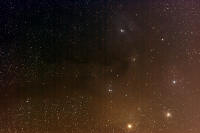 |
| The Virgo Cluster of Galaxies - 14 April 2007
Here's my version of the poor man's Hubble ultra deep field. After making my
way to John's backyard last night, I aimed my 200mm lens at the
constellations Virgo and Coma Berenices. Unlike the Hubble ultra deep field
I couldn't afford to keep the shutter open for days on. Still I was able to
expose for about 40 minutes and got a picture that reveals dozens of
galaxies. Notice the Markarian's Chain and the Siamese Twins. The field is
approximately 6.4 x 4.2 degrees and north is up.
Taken: 14 April 2007 from John McDonald's backyard, Victoria.
Optics: Canon 200mm f/2.8 Lens on Kenko SkyMemo Mount.
Camera: Canon 20Da
Exposures: 54 light frames of 30 sec @ ISO 400, and 21 light frames of 45
sec @ISO 400. Lens stopped down to f/3.5.
Processing: ImagesPlus- Dark, and flat calibration. Files combined using
MinMax Excluded. Digital Development. Colour balance. Neat Image- Noise
reduction. |
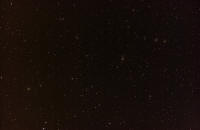
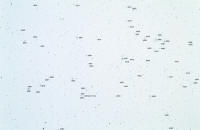
Mouseover version of 2
images |
| ASTEROID 2006 VV2 - 31 March 2007 Thanks to a
200mm camera lens, John McDonald's go-to capabilities, and a bit of luck I was
successful in imaging 2006 VV2. Here is the result of 24 stacked (and
cropped) images showing asteroid 2006 VV2.
Taken: 31 March 2006 from the DAO. 1 April 2007 05:07 UT to 1 April 2007
05:28 UT
Optics: Canon 200mm f/2.8 Lens on Kenko SkyMemo Mount.
Camera: Canon 20Da
Exposures: 24 light frames of 45 sec @ ISO 100. Lens stopped down to f/4.0.
Processing: ImagesPlus and Neat Image. |
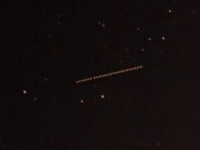 |
| The Horsehead Nebula-B33, The Flame Nebula-NGC 2024, IC
434, M78 - 26 January 2007 Last Wednesday, I imaged the Horsehead
Nebula from John McDonald's backyard using a new Canon 200mm f/2.8 lens.
Unfortunately, the use of a UV filter on the lens created ghost images and
ruined my picture. So on Friday night I attempted to capture the same
target, without any filter, from the DAO. Success at last! No artifacts are
visible in this picture. On the other hand, the version of my picture taken
from John's location seems less affected by light pollution. Notice M78 in
the frame.
Taken: 26 January 2007 from the DAO, main parking lot.
Optics: Canon EF 200mm f/2.8 II on Kenko SkyMemo mount.
Camera: Canon 20Da
Exposures: 275 light frames of 20 sec(~1hr,31min), ISO 800 working at f/3.5
Processing: ImagesPlus- Dark, flat, and bias calibration. Files combined
usingMinMax Excluded. Digital Development.Photoshop- Screen Applied. Neat
Image- Noise reduction |
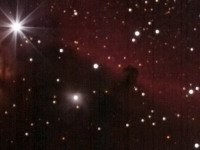 |
| M45, The Pleiades - 11 January 2007 John McDonald
and I went to the DAO on Thursday night. I set up in the lower parking lot
which in retrospect was probably not the best decision due to the city
lights. Here's my image of the Seven Sisters.
Taken: 11 January 2007 from the DAO, lower parking lot.
Optics: TeleVue NP-101, f/5.4 on Losmandy G-11.
Camera: Canon 20Da
Exposures: 75 light frames of 60 sec @ ISO 800.
Processing: ImagesPlus- Dark, flat, and bias calibration. Files combined
using MinMax Excluded. Digital Development. Photoshop- Screen Applied. Color
balance. Neat Image- Noise reduction. |
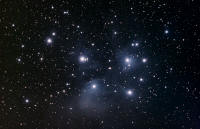 |
| The Orion Nebula - M42, M43, NGC 1977, and NGC 1981 - 11
January 2007 Here is my picture of the Orion Nebula taken on Thursday
night from the DAO. I meant to take short exposures in order to image the
trapezium but I forgot. As a result the core is overexposed. Colour balance
is always challenging with my Canon 20Da and I hope that my choice of colour
temperature is pleasing.
Taken: 11 January 2007 from the DAO, lower parking lot.
Optics: TeleVue NP-101, f/5.4 on Losmandy G-11.
Camera: Canon 20Da
Exposures: 53 light frames of 60 sec @ ISO 800.
Processing: ImagesPlus- Dark, flat, and bias calibration. Files combined
using MinMax Excluded. Digital Development. Photoshop- Screen Applied.
Colour balance. Neat Image- Noise reduction |
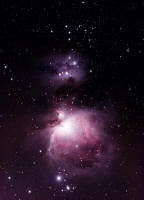 |
| |
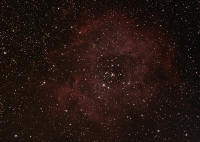 |
Rosette Nebula - NGC 2237-39, 2246 and NGC 2244 - 28
December 2006 Four members met at the old 16" site tonight. It was
nice to finally have a clear sky. It gave must of us the opportunity to try
out new gear. The astrophotographers focused on the Orion and Rosette
nebulae. My plan was to wait for the quarter moon to set before proceeding
to image the Rosette nebula. Unfortunately, clouds moved in at around 00:30
and I only exposed for about 13 minutes before packing up my gear.
Taken: 28 December 2006 from the DAO.
Optics: TeleVue NP-101, f/5.4 on Losmandy G-11.
Camera: Canon 20Da
Exposures: 9 light frames of 90 sec @ ISO 800.
Processing: ImagesPlus and Neat Image. |
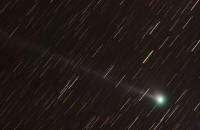 |
Comet C/2006 M4 Swan - 29 October 2006 Guy and I
were treated with excellent viewing conditions last night at the DAO. We
both imaged comet SWAN and here is my result. The tail of the comet is so
long I could not frame it all!
Taken: 29 October 2006 from the DAO
Optics: TeleVue NP-101, f/5.4 on Losmandy G-11
Camera: Canon 20Da
Exposures: 75 light frames of 60 sec @ ISO 800
Processing: ImagesPlus and Neat Image |
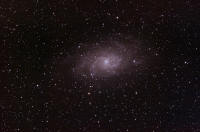 |
M33/NGC 598 - 20 October 2006 Taken: 20 October
2006 from Bruno's backyard in Oak Bay.
Optics: TeleVue NP-101, f/5.4 on Losmandy G-11.
Camera: Canon 20Da
Exposures: 60 light frames of 60 sec @ ISO 800.
Processing: ImagesPlus, Photoshop and Neat Image. |
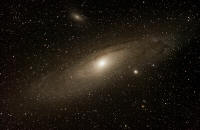 |
M31, M32, M110 - 28 August 2006
Guy Walton and I went to the DAO last Sunday. I took this picture of the
Andromeda Galaxy from the old 16" site. Transparency was poor, thin layers
of clouds covered the sky. All my 72 shots were graded "F" by ImagesPlus,
likely the result of poor seeing. Nonetheless, my final result looks good.
Notice NGC 206, the star cloud within M31, clearly visible in this frame.
Taken: 28 August 2006 from the DAO.
Optics: TeleVue NP-101, f/5.4, on Vixen GP-DX mount.
Camera: Canon 20Da
Exposures: 72 light frames of 60 sec @ ISO 800.
Processing: ImagesPlus and Neat Image. 15 darks, 15 flats and 15 bias frames
used during processing. |
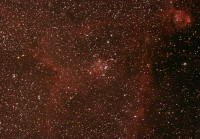 |
Melotte 15, IC 1795 and NGC 896 - 27 August 2006
Joe, David, Guy, and I set up at the old 16" site this past Saturday. The
view through David's NP-101is was breathtaking. The whole Veil Nebula was
visible with the help of Guy's 31mm Nagler and an OIII filter. While
admiring David's new purchase, my camera was busy gathering photons from IC
1805. Located in Cassiopeia, this nebula covers a wide field of view. I was
able to capture only part of it in my frame. The open cluster in the centre
of this image is Melotte 15 (mag 6.5; 20'). The nebulae IC 1795 and NGC 896
are in top right corner. Half way between NGC 896 and Mel 15 lies the faint
open cluster Tom 4 (from Clyde Tombaugh's Small List of Open Clusters).
Taken: 27 August 2006 from the DAO.
Optics: TeleVue NP-101, f/5.4, on Vixen GP-DX mount.
Camera: Canon 20Da
Exposures: 122 light frames of 60 sec @ ISO 800. |
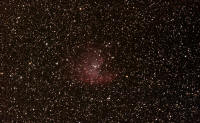 |
NGC 281, Pacman Nebula / IC 1590 - 25 August 2006
Joe, Guy, Malcolm, and I went to Cattle Point last night. While my dew
heaters were fighting the high humidity, I obtained this picture of NGC 281.
This emission nebula is located in Cassiopeia. Also known as the Pacman
Nebula, NGC 281 surrounds the small open cluster IC 1590.
Taken: 25 August 2006 from Cattle Point.
Optics: TeleVue NP-101, f/5.4, on Vixen GP-DX mount.
Camera: Canon 20Da
Exposures: 146 light frames of 60 sec @ ISO 800.
Processing: ImagesPlus. 15 darks, 15 flats and 15 bias frames used during
processing. |
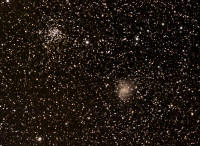 |
NGC 6939 and NGC 6946 - 20 August 2006
Another picture taken from Pearson College following the annual picnic. NGC
6939 is an open cluster (10' x 10') of magnitude 7.8 and NGC 6946 a spiral
galaxy of magnitude 8.8. The pair lie in Cepheus.
Taken: 20 August 2006 from Pearson College.
Optics: TeleVue NP-101, f/5.4, on Vixen GP-DX mount.
Camera: Canon 20Da
Exposures: 130 light frames of 60 sec @ ISO 800.
Processing: ImagesPlus. Cropped image. 15 darks, 15 flats and 15 bias frames
used during processing. |
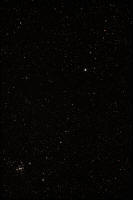 |
Kemble's Cascade and NGC 1502 - 20 August 2006
Kemble's Cascade is a two-degree-long chain of fifth-to-eight-magnitude
stars. Named after Canadian observer Father Lucien Kemble (1922-1999), it is
located in Camelopardalis. I managed to get this picture of the Cascade last
Saturday following the Centre's annual picnic at Pearson College. North is
up in this image and Kemble's Cascade runs from the top right corner down to
the open cluster NGC 1502. The small cluster looked very interesting through
Bill Weir's telescope. It reminded us of the ET cluster (NGC 457); indeed,
two of the stars in the cluster appeared as a pair of eyes looking back at
us.
Taken: 20 August 2006 from Pearson College.
Optics: TeleVue NP-101, f/5.4, on Vixen GP-DX mount.
Camera: Canon 20Da
Exposures: 32 light frames of 45 sec @ ISO 800. |
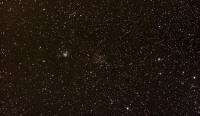 |
NGC 7129 and NGC 7142 - 19 August 2006
A few members met at Cattle Point this past Friday. I imaged this pair of
objects located in Cepheus. NGC 7129 is the reflection nebula/open cluster.
The open cluster NGC 7142 (12' x 12', magnitude 9.3) is to the right of NGC
7129. If you're looking for a challenge, try locating PGC 97261. At
magnitude 16.4, this galaxy appears as a bare speck in this image.
Taken: 19 August 2006 from Cattle Point.
Optics: TeleVue NP-101, f/5.4, on Vixen GP-DX mount.
Camera: Canon 20Da
Exposures: 123 light frames of 60 sec @ ISO 800.
Processing: ImagesPlus. 15 darks, 15 flats and 15 bias frames used during
processing. |
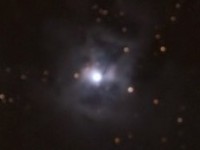 |
The Iris Nebula - NGC 7023 - 18 August 2006 I took
this picture of the Iris Nebula from Cattle Point on Thursday night. The
small reflection nebula (10' x 8') is located in Cepheus and surrounds a 7th
magnitude star. Of interest in this picture is the Mira-type variable star T
Cephei (HD 202012). Look for the bright reddish star located in the bottom
left corner of this image. T Cephei has a period of 388 days and fluctuates
between magnitude 5.2 and 11.3.
Taken: 18 August 2006 from Cattle Point.
Optics: TeleVue NP-101, f/5.4, on Vixen GP-DX mount.
Camera: Canon 20Da
Exposures: 103 light frames of 60 sec @ ISO 800.
Processing: ImagesPlus and Neat Image. 15 darks, 15 flats and 15 bias frames
used during processing. |
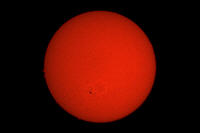 |
The Sun - 16 August 2006 After borrowing a few
bits and pieces from Bruno, I thought I'd give solar photography another
try. I drove to Mount Tolmie Park on Wednesday and pointed the Centre's
Coronado Solarmax telescope at the Sun. I started shooting using Bruno's
2.5x Powermate but found eyepiece projection method more forgiving. This
image was acquired using an 18mm Coronado eyepiece. I took a series of short
exposures (1/320 to 1/800) to emphasize the details on the surface of the
Sun and somewhat longer exposures (1/125) to capture Sun's flares. Thanks to
John McDonald for superimposing and blending my two sets of images.
Taken: 16 August 2006 from Mount Tolmie Park. Time: 17:00 PDT.
Optics: Coronado Solarmax 40 on Vixen GP-DX mount using eyepiece projection
(18mm Coronado Eyepiece).
Camera: Canon 20Da
Exposures: Surface details: 21 light frames (9-1/320 sec, 8-1/500 sec and
4-1/800sec @ISO 200). Flares details: 3 light frames (1/125 sec @ISO200).
Processing: ImagesPlus. Extra processing by John McDonald using Photoshop. |
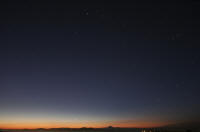 |
Morning Stars Rising - 7 August 2006
Here's how the eastern sky looked early this morning from Mount Tolmie Park.
Gemini and Orion are seen rising above the horizon while Capella (in Auriga)
and the Hyades (in Taurus) are well above it. I observed both Venus and
Mercury naked eye. In this picture, Venus, at magnitude -3.9, appears as a
bright star below Castor and Pollux in Gemini. Mercury, at magnitude 0.1, is
harder to see in this image. It is located approximately 2.5 degrees below
Venus (barely clearing the horizon).
Taken: 7 August 2006 from Mount Tolmie Park at 04:27.
Optics: Canon EF 17-40mm f/4L USM Lens.
Camera: Canon 20Da
Exposures: One single JPEG shot of 25 sec at ISO400. Lens set at 17mm, f/4.
Processing: Canon built-in noise reduction and Neat Image. |
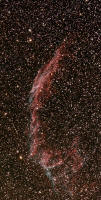 |
The Veil Nebula (Eastern Segment) NGC 6992 and NGC 6995
- 5 August 2006
Here's an image I took of the Eastern section of the Veil Nebula. It was
taken early Saturday morning from Cattle Point. The seeing conditions were
not great, the air was full of moisture. I waited for the moon to set, at
around 01:00, before proceeding with the shoot. Today, I paid John McDonald
a visit and he kindly demonstrated of few of his image processing
techniques. Using Photoshop, John applied a filter to my image that improved
the details. Thanks for the demo John.
Taken: 5 August 2006 from Cattle Point.
Optics: TeleVue NP-101 f/5.4 on Vixen GP-DX mount.
Camera: Canon 20Da
Exposures: 73 light frames of 60 sec @ISO 800.
Processing: ImagesPlus. 15 darks, 15 flats and 15 bias frames used during
processing. Extra processing by John McDonald using Photoshop CS2. |
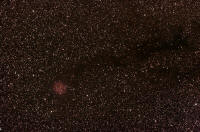 |
The Cocoon Nebula IC 5146 and Barnard 168 - 2 Aug 2006
I set up at Cattle Point on Tuesday night and aimed my scope towards the
Cocoon Nebula in Cygnus. It was a bit windy but I was able to expose for
over two hours. Also captured in this image is the dark nebula B168.
Taken: 2 August 2006 from Cattle Point.
Optics: TeleVue NP-101 f/5.4 on Vixen GP-DX mount.
Camera: Canon 20Da
Exposures: 123 light frames of 60 sec @ISO 800.
Processing: ImagesPlus. 15 darks, 15 flats and 15 bias frames used during
processing.
|
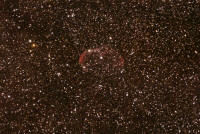 |
NGC 6888 The Crescent Nebula - 25 July 2006
I headed for the Hill on Monday night after an invitation from David Lee.
Once there, I set up at the old 16" site and took this picture of the
Crescent Nebula. The nebula, also known as Caldwell 27, is located in
Cygnus. This is a cropped image.
Taken: 25 July 2006 from the DAO.
Telescope: TeleVue NP-101 f/5.4 on Vixen GP-DX mount.
Camera: Canon 20Da
Exposures: 52 light frames of 60 sec @ ISO 800.
Processing: ImagesPlus and Neat Image. 15 darks, 15 flats and 15 bias frames
used during processing. |
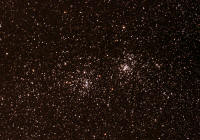 |
The Double Cluster (NGC 884 and NGC 869 ) - 23 July 2006
The Cowichan Valley StarFinders held their star party on the Malahat this
past weekend. The weather was perfect for camping and observing. I spent
Friday night observing the night sky and took this picture of the Perseus
double cluster on Saturday night.
Taken: 23 July 2006 from the Victoria Fish and Game Association, Malahat.
Telescope: TeleVue NP-101 f/5.4 on Vixen GP-DX mount.
Camera: Canon 20Da
Exposures: 69 light frames of 60 sec @ ISO 800.
Processing: ImagesPlus and Neat Image. 15 darks, 15 flats and 15 bias frames
used during processing. |
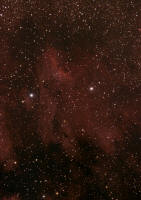 |
The Pelican Nebula (IC 5067) - 21 July 2006 Taken:
21 July 2006 from the DAO, the old 16" site
Telescope: TeleVue NP-101 f/5.4 on Vixen GP-DX mount.
Camera: Canon 20Da
Exposures: 67 light frames of 60 sec @ ISO 800.
Processing: ImagesPlus and Neat Image. 15 darks, 15 flats and 15 bias frames
used during processing. |
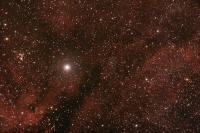 |
Gamma Cygni Nebula (IC 1318) - 19 July 2006 John
and I had exceptional seeing conditions at Cattle Point, so I was able to
expose part of the Gamma Cygni Nebula (IC 1318)
for over 60 minutes. Notice the open cluster NGC 6910 on the left.
Taken: 19 July 2006 from Cattle Point.
Telescope: TeleVue NP-101 f/5.4 on Vixen GP-DX mount.
Camera: Canon 20Da
Exposures: 76 light frames of 60 sec @ ISO 800.
Processing: ImagesPlus and Neat Image. 15 darks, 15 flats and 15 bias frames
used during processing. |
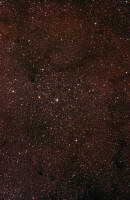 |
IC 1396 / VdB 142 - 16 July 2006 I went to the DAO
last night and set up at the old 16" site. I have captured part of the large
emission nebula IC 1396 located in Cepheus. North is up in this picture. The
bright double or multiple star in the centre of the frame is SAO 33626. To
the right of it is VdB 142 which is also known as the elephant's trunk
nebula. The dark nebula Barnard 161 is located north of SAO 33626.
Two more dark nebulae, B163 and B365 are also visible in the bottom of the
frame.
Taken: 16 July 2006 from the DAO.
Telescope: TeleVue NP-101 f/5.4 on Vixen GP-DX mount.
Camera: Canon 20Da
Exposures: 39 light frames of 60 sec @ ISO 800.
Processing: ImagesPlus. 15 darks, 15 flats and 15 bias frames used during
processing |
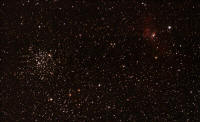 |
M52 and NGC 7635 - 16 July 2006 Another image from
last night. M52 and the Bubble Nebula (NGC 7635) located in Cassiopeia. A
Televue PowerMate was used for this shot.
Taken: 16 July 2006 from the DAO.
Telescope: TeleVue NP-101 f/5.4 with 2x PowerMate (effective focal length:
1080mm) on Vixen GP-DX mount.
Camera: Canon 20Da
Exposures: 24 light frames of 45 sec @ ISO 800.
Processing: ImagesPlus and Neat Image. 15 darks, 15 flats and 15 bias frames
used during processing. |
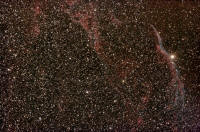 |
NGC 6960 The Filamentary Nebula - 3 July 2006 It
was kind of windy yesterday night at Cattle Point. But by midnight the wind
had subsided. I was hoping to get the whole of the Veil Nebula in the frame
but came short. The western segment of the Veil Nebula (NGC 6960) is on the
right side of this image. The bright star is 52 Cygni. NGC 6967 and 6974 are
visible on the left.
Taken : 3 July 2006 from Cattle Point.
Telescope: TeleVue NP-101 f/5.4 on Vixen GP-DX mount.
Camera: Canon 20Da
Exposures: 72 light frames of 60 sec @ ISO 800. 15 darks, 15 flats and 15
bias frames.
Processing: ImagesPlus and Neat Image. Full Frame. |
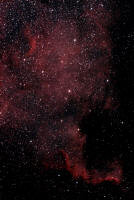 |
NGC 7000 The North America Nebula - 2 July 2006
Saturday was a great night at the DAO. Seeing conditions were exceptional
and I focused my attention on the North America Nebula in Cygnus.
Taken : 2 July 2006 from the DAO.
Telescope: TeleVue NP-101 f/5.4 on Vixen GP-DX mount.
Camera: Canon 20Da
Exposures: 40 light frames of 60 sec @ ISO 800. Processed and cropped with
ImagesPlus. 15 darks, 15 flats and 15 bias frames used during processing. |
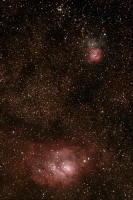 |
M8, Lagoon Nebula & M20, Trifid Nebula - 1 July 2006
Taken : 1 July 2006 from Pearson College.
Telescope: TeleVue NP-101 f/5.4 on Vixen GP-DX mount.
Camera: Canon 20Da
Exposures: 20 light frames of 60 sec @ ISO 800. 15 darks, 15 flats and 15
bias frames.
Processing: ImagesPlus |
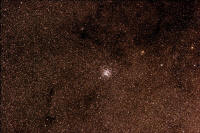 |
M11/NGC 6705 The Wild Duck Cluster - 29 June 2006
Taken : 29 June 2006 from Cattle Point
Telescope: TeleVue NP-101 f/5.4 on Vixen GP-DX mount.
Camera: Canon 20Da
Exposures: 31 light frames of 60 sec @ ISO 800. Processed, cropped with
ImagesPlus and Neat Image. 15 darks, 15 flats and 15 bias frames used during
processing. |
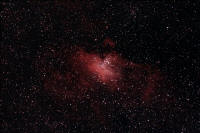 |
M16/NGC 6611 The Eagle Nebula - 27 June 2006
Taken : 27 June 2006 from Cattle Point
Telescope: TeleVue NP-101 f/5.4 with 2" Lumicon Deep Sky Filter on Vixen
GP-DX mount.
Camera: Canon 20Da
Exposures: 34 light frames of 60 sec @ ISO 800. Processed, cropped with
ImagesPlus and Neat Image. 15 darks, 15 flats and 15 bias frames used during
processing. |
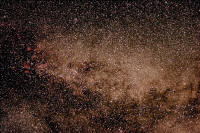 |
Gamma Cygni Region - 26 June 2006
Wide angle picture of Cygnus taken with Canon 50mm lens (covers
approximately 25 by 17 degrees). The bright star on the left is 37 Gamma
Cygni (Sadr). Notice the nebulosity in that region. 6 Beta Cygni (Albireo)
is located to the right of Sadr.
Taken : 26 June 2006 from Cattle Point
Telescope: Canon 50mm f/1.4 lens stopped at f/3.2 on Vixen GP-DX
Camera: Canon 20Da
Exposures: 12 shots of 120 sec @ ISO 800. Processed with ImagesPlus. 15
darks, 15 flats and 15 bias frames used during processing. |
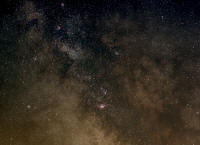 |
Sagittarius Star Cloud Region - 26 June 2006
John McDonald and I ended up going to Cattle Point on Sunday and Monday
nights. As you may have seen already, John took a wonderful shot of both M20
and M8. For my part, I decided to try out wide field astrophotography. This
is the first of two shots I captured using the Canon 50mm f/1.4 lens.
Unfortunately sky glow turned out to be problematic and part of the original
frame was taken out.
Some objects of interest in this picture: M16 The Eagle Nebula, M17 The
Lagoon Nebula, M18, M25, M24 The Sagittarius Stat Cloud a.k.a. Delle
Caustiche, M23, M21, M20 The Trifid Nebula, M22, M8 The Lagoon Nebula, M28
and a lot more...
Taken : 26 June 2006 from Cattle Point
Telescope: Canon 50mm f/1.4 lens stopped at f/3.2 on Vixen GP-DX
Camera: Canon 20Da
Exposures: 9 shots of 120 sec @ ISO 800. Processed with ImagesPlus and Neat
Image. 15 darks, 15 flats and 15 bias frames used during processing. |
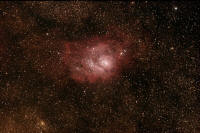 |
M8 The Lagoon Nebula & NGC 6523 - 24 June 2006
The globular star cluster in the bottom left corner of the frame is NGC 6544
Taken : 24 June 2006 from Pearson College
Telescope: TeleVue NP-101 f/5.4 on Vixen GP-DX mount.
Camera: Canon 20Da
Exposures: 21 light frames of 60 sec @ ISO 800. Full frame processed with
ImagesPlus and Neat Image. 15 darks, 15 flats and 15 bias frames used during
processing. |
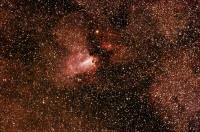 |
M17/NGC 6618 The Swan Nebula - June 24, 2006
Finally some clear skies. I went to Pearson College last night and was
rewarded with some good seeing conditions. Although Sagittarius is fairly
low in the sky from our location in Victoria, I managed to get some fair
results imaging the Swan Nebula.
Taken : 24 June 2006 from Pearson College
Telescope: TeleVue NP-101 f/5.4 on Vixen GP-DX
Camera: Canon 20Da
Exposures: 16 shots of 90 sec @ ISO 800. Processed with ImagesPlus and Neat
Image. 15 darks, 15 flats and 15 bias frames used during processing. |
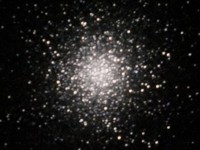 |
M13 - May 18, 2006 - Looks like M13 was the target
of choice last Thursday. I used my NP-101 coupled to a 2x Powermate in my
attempt at capturing this globular cluster. Only 9 shots out of 40 made it
past "quality control". Turns out that shooting at a focal length of over
1000mm is quite the challenge.
Telescope: TeleVue NP-101 f/5.4 with 2x Powermate (f.l. 1080mm f/10.8) on
Vixen GP-DX
Camera: Canon 20Da
Exposures: 9x60 sec @ISO 800 processed with ImagesPlus and Neat Image |
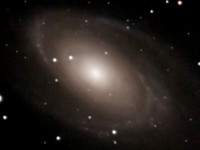 |
M81 - May 2, 2006 - After seeing a demonstration of
Neat Image from Joe a few weeks ago I proceeded in acquiring the
aforementioned program. Here's my shot of M81 taken from Cattle Point
on May 2, 2006 processed with Neat Image.
Telescope: Televue NP-101 f/5.4 on Vixen GP-DX
Camera: Canon 20Da
Exposures: 30x90 sec @ISO 800 processed with ImagesPlus and Neat Image |
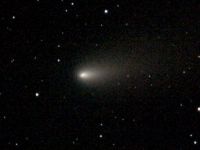 |
Comet 73/P Schwassmann-Wachmann - April 22, 2006 - A few
of us met at Pearson College last night. I had a great time although
transparency wasn't the best. I took shots of the Leo Triplet and comet
Schwassmann-Wachmann. Telescope: Tele Vue NP-101
Camera: Canon 20Da
Exposures: 3X60 sec @ISO 800 Processed with Images Plus. |
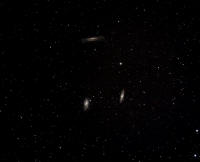 |
Leo Triplet M65, M66 , NGC 3628 - April 22, 2006 - A
few of us met at Pearson College last night. I had a great time although
transparency wasn't the best. I took shots of the Leo Triplet and comet
Schwassmann-Wachmann. Telescope: Tele Vue NP-101
Camera: Canon 20Da
Exposures: 11X60 sec @ISO 800 Processed with Images Plus. |
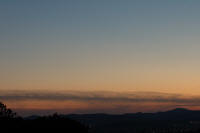 |
Venus-Jupiter-Moon - Sept 5, 2005 evening twilight from Mount Tolmie. Taken with Nikon D70 and AF-S VR Nikkor
70-200mm zoom-lens
80mm fl, f/5, 1/20 sec,. ISO 400 |
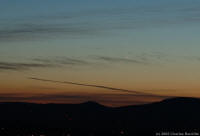
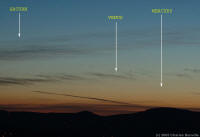 |
Planetary
Conjunction - Venus-Mercury-Saturn - June 19, 2005 10:02pm, from Mount
Tolmie. Taken with Nikon D70 and AF-S VR Nikkor 70-200mm zoom-lens
70mm fl, f/2.8, 1/3 sec,. ISO 200
|
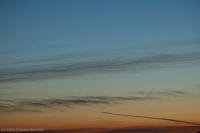 |
Planetary Conjunction - Venus-Mercury-Saturn - June
19, 2005 10:02pm, from Mount Tolmie. Taken with Nikon D70 and AF-S VR Nikkor
70-200mm zoom-lens
120mm fl, f/2.8, 1/5 sec, ISO 200 |
|